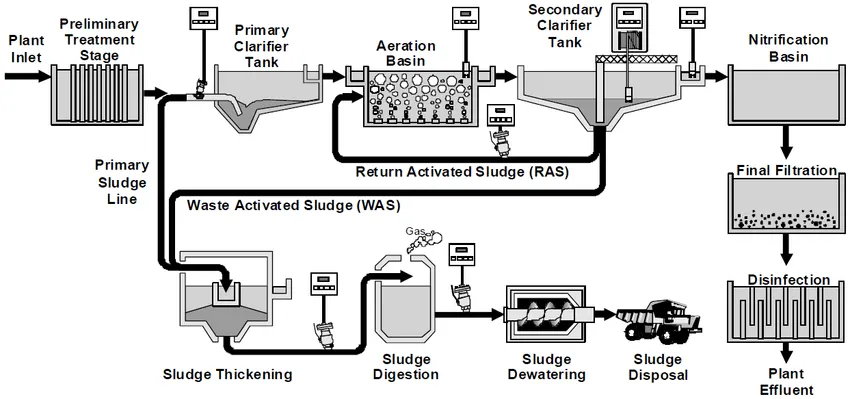How do Sewage Treatment Plants Work Flow Diagram?
An STP (Sewage Treatment Plant) is a facility designed to treat wastewater and sewage generated from residential, commercial, and industrial sources. The primary purpose of an STP is to remove contaminants from sewage to produce treated effluent that can be safely released into the environment or reused.
Key Functions of an STP Plant:
Wastewater Collection: Sewage is collected from various sources through a network of pipes.
Preliminary Treatment: Large solids and debris are removed through screening and grit removal processes.
Primary Treatment: Sedimentation tanks allow solids to settle out, forming sludge, while lighter materials like oils are skimmed off.
Secondary Treatment: Biological processes are used to further degrade organic matter. This often involves aeration tanks where microorganisms consume the waste.
Tertiary Treatment: Advanced processes, such as filtration or chemical treatment, are used to polish the water and remove remaining impurities.
Sludge Management: The sludge collected during primary and secondary treatment undergoes further processing, such as digestion or dewatering, for disposal or beneficial reuse.
Effluent Discharge: The treated water, or effluent, is then discharged into rivers, lakes, or reused for irrigation and other purposes.

STP Plant Workflow Diagram :
A typical flow diagram for a Sewage Treatment Plant (STP) illustrates the stages of wastewater treatment. Here’s a simplified description of the process:
Influent: Wastewater enters the STP from various sources.
Screening: Large solids and debris are removed using screens.
Grit Removal: Grit and sand settle out in a grit chamber.
Primary Treatment: Wastewater flows into primary clarifiers where solids settle to the bottom, forming sludge. Oils and greases float to the top and are skimmed off.
Secondary Treatment:
- Aeration: Wastewater is aerated to promote the growth of microorganisms that break down organic matter.
- Secondary Clarification: The mixture is then sent to secondary clarifiers where the biomass settles out, forming activated sludge.
Tertiary Treatment: This stage may include filtration, chemical treatment, or UV disinfection to further purify the water.
Discharge: The treated effluent is released into a water body or reused for irrigation or industrial processes.
Sludge Treatment: The collected sludge undergoes further processing, such as anaerobic digestion or drying, before disposal or use as fertilizer.
Enquire Now
Recent Posts
- What Is an Industrial RO (Reverse Osmosis) Plant, And How Does It Work?
- LPH in RO Water Purifier
- What is Activated Sludge Process?
- Normal TDS Level in Drinking Water
- Difference Between Effluent and Sewage Treatment Plants
- What is E20 Gasoline
- What is E20 Fuel? Benefits, Effects on Engines, and How Biofuel Supports India’s Growth
- What is Transmembrane Pressure (TMP)?
- Effluent Treatment Plant Manufacturers in Pune
- Sewage Treatment Plant Manufacturers in Pune

